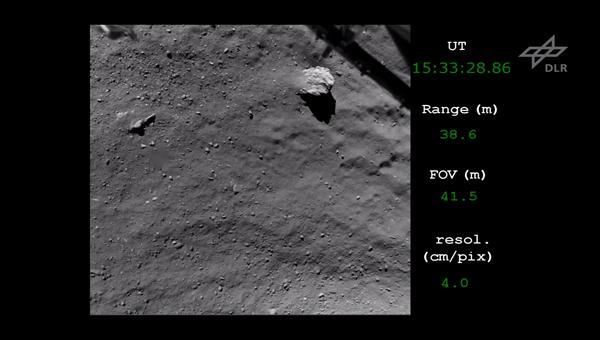Company for the Philae lander

ESA/Rosetta/MPS for OSIRIS Team MPS/UPD/LAM/IAA/SSO/INTA/UPM/DASP/IDA.

Your consent to the storage of data ('cookies') is required for the playback of this video on Quickchannel.com. You can view and change your current data storage settings at any time under privacy.
ESA/Rosetta/Philae/ROLIS/DLR
The Philae landing craft touched down on comet on 12 November 2014. It has now been found: it is not located at the convenient site originally selected for its landing, but rather – following a series of three bounces – in a grim and dark environment. All the same, the lander is now set to receive company: the European Space Agency (ESA) Rosetta orbiter, which until now has been orbiting the comet, is scheduled to be brought down to the surface of Churyumov-Gerasimenko on 30 September 2016. Although the fourth 'touchdown' will not be a landing in any traditional sense and will instead resemble a gentle impact, the orbiter and lander will nevertheless continue to travel together around the Sun. "The moment at which a mission to which you have dedicated two decades of work irrevocably comes to an end with this kind of impact is, of course, a rather sentimental occasion," says Philae project manager Stephan Ulamec from the German Aerospace Center (Deutsches Zentrum für Luft- und Raumfahrt; DLR). "But on the other hand, we have collected so much data that there is no real reason to be sad."
Last measurements, final photographs
The last contact with Philae took place on 9 July 2015. Once Rosetta impacts on the coomet, it will no longer have any means of communicating with Earth. Before that happens, scientists intend to descend toward the comet's surface as slowly as possible in order to complete last measurements and acquire the last images. Rosetta will conclude its mission in the Ma'at region – also located on the head of the 'duck-shaped' comet. "This is a particularly active area, with cavities that spew gas and dust into space," explains Ulamec. This kind of area would have been avoided two years ago, when Philae separated from the Rosetta orbiter before touching down on the comet's surface for the first time. "We were particularly concerned to ensure a targeted, precise landing in fairly secure terrain." But plans turned on their head when the lander's harpoons failed to hold the probe in place the first time it made contact the surface. Nevertheless, the team at the DLR Lander Control Center (LCC) was able to work with Philae for 55 hours, collecting scientific data – even at its unintended location. This was the first time that any probe had directly sniffed, hammered, drilled and photographed the surface of a comet.
The journey is the reward
"In contrast, the journey is the real reward with Rosetta," says Ulamec. After all, the really skilful part will be when several instruments are switched on during the descent, and as such will transmit the last data acquired just before impact to Earth. The final photograph is scheduled to be taken and beamed home a mere 15 seconds before impact and the consequent loss of communication. Back in November 2014, Philae sent back data until the last flicker of life trickled out of its batteries and it fell into hibernation, waiting to be recharged by solar power. Ground control was only able to receive a smidgen of data when it made contact later on. Philae's antennas are likely to have suffered damage under the low temperature conditions, and this may have contributed to the irregular contact and subsequent silence. Everyone involved fervently hopes that contact with Rosetta will not break off too early, and that valuable data will be acquired. It will take scientists many years to analyse the data acquired by the ESA Rosetta mission so far. "The results will shape our perception of comets for years to come, while deepening our understanding of how the Solar System formed and of the origin of life," Ulamec confidently asserts.
A final, slow motion goodbye
When Rosetta bids farewell, it will do so slowly: the final close orbits were completed on 26 September 2016, and now the orbiter is being prepared for its descent. When the time comes and Rosetta begins its slow approach toward the comet's surface, 67P/Churyumov-Gerasimenko will be almost 720 million kilometres from Earth. The traces of Rosetta's earthbound signal will fall silent at around 13:20 Central European Time (plus/minus 20 minutes). By then, the orbiter will already have impacted on the surface, as the signal travels for approximately 40 minutes before it is received.
Comets and asteroids
Rosetta's impact on 30 September 2016 will mark the end of a mission that ventured into space on 2 March 2004, but whose initial idea and development period began much earlier. "It is now important to learn more about the small bodies drifting through the Solar System – that is, comets and asteroids," says Ulamec. "Without follow-up missions, the unique global capability in the construction and operation of orbiters like Rosetta or landing probes like Philae would become forfeit." The MASCOT asteroid lander is currently winging its way on board the Japanese Hayabusa2 orbiter toward asteroid Ryugu, where it is scheduled to arrive in summer 2018. Then, the DLR Control Center in Cologne will handle MASCOT's landing on the asteroid. In addition, as part of the Asteroid Impact Mission (AIM), with MASCOT-2, more landers are on the way for possible missions to an asteroid.
The success of the exhibition 'Comets: the Rosetta Mission - A journey to the origins of the Solar System', which DLR organised together with the Berlin Natural History Museum and the Max Planck Society, and which has been on display since 9 August 2016, demonstrates the fascination that comets exude: since it opened, over 100,000 people have visited the special showcase at the Natural History Museum in Berlin.

